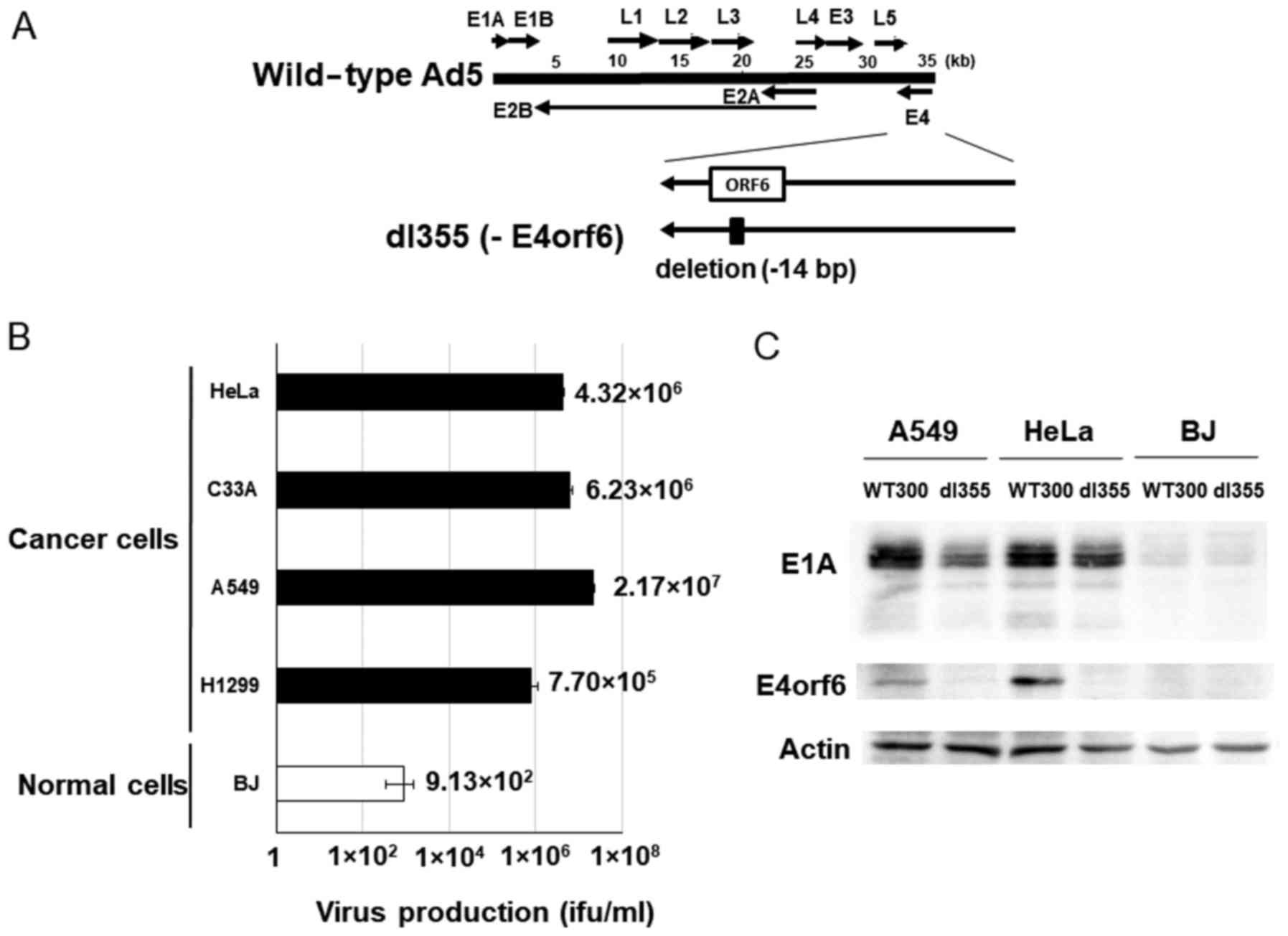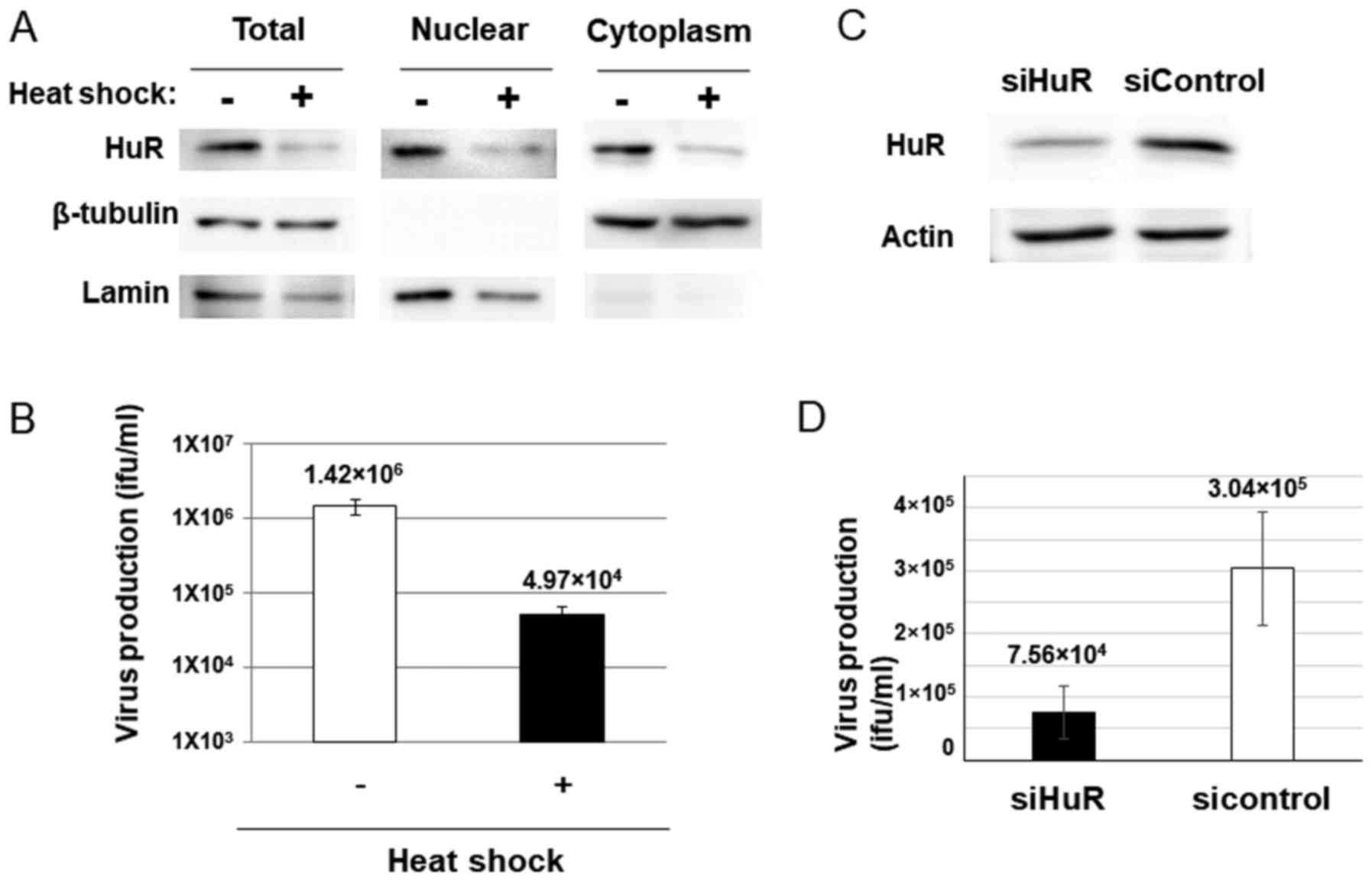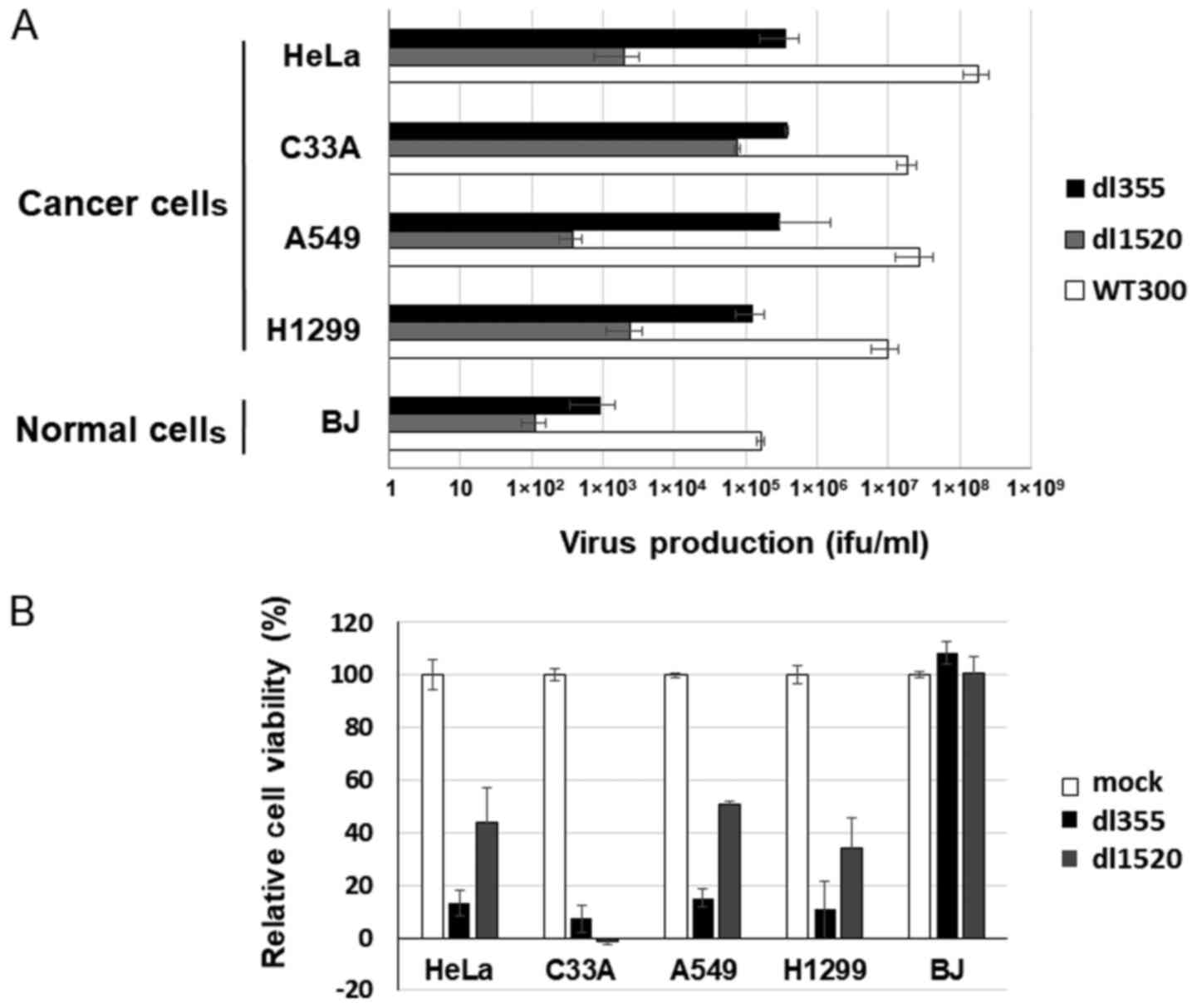|
1
|
Shenk T: Adenoviridae: The viruses and
their replication. Fundamental Virology. Knipe DM and Howley PM:
4th. Lippincott Williams & Wilkins Ltd.; Philadelphia: pp.
1053–1088. 2001
|
|
2
|
Halbert DN, Cutt JR and Shenk T:
Adenovirus early region 4 encodes functions required for efficient
DNA replication, late gene expression, and host cell shutoff. J
Virol. 56:250–257. 1985.PubMed/NCBI
|
|
3
|
Sarnow P, Hearing P, Anderson CW, Halbert
DN, Shenk T and Levine AJ: Adenovirus early region 1B 58,000-dalton
tumor antigen is physically associated with an early region 4
25,000-dalton protein in productively infected cells. J Virol.
49:692–700. 1984.PubMed/NCBI
|
|
4
|
Querido E, Blanchette P, Yan Q, Kamura T,
Morrison M, Boivin D, Kaelin WG, Conaway RC, Conaway JW and Branton
PE: Degradation of p53 by adenovirus E4orf6 and E1B55K proteins
occurs via a novel mechanism involving a Cullin-containing complex.
Genes Dev. 15:3104–3117. 2001. View Article : Google Scholar : PubMed/NCBI
|
|
5
|
Harada JN, Shevchenko A, Shevchenko A,
Pallas DC and Berk AJ: Analysis of the adenovirus E1B-55K-anchored
proteome reveals its link to ubiquitination machinery. J Virol.
76:9194–9206. 2002. View Article : Google Scholar : PubMed/NCBI
|
|
6
|
Luo K, Ehrlich E, Xiao Z, Zhang W, Ketner
G and Yu XF: Adenovirus E4orf6 assembles with
Cullin5-ElonginB-ElonginC E3 ubiquitin ligase through an HIV/SIV
Vif-like BC-box to regulate p53. FASEB J. 21:1742–1750. 2007.
View Article : Google Scholar : PubMed/NCBI
|
|
7
|
Cheng CY, Blanchette P and Branton PE: The
adenovirus E4orf6 E3 ubiquitin ligase complex assembles in a novel
fashion. Virology. 364:36–44. 2007. View Article : Google Scholar : PubMed/NCBI
|
|
8
|
Stracker TH, Carson CT and Weitzman MD:
Adenovirus oncoproteins inactivate the Mre11-Rad50-NBS1 DNA repair
complex. Nature. 418:348–352. 2002. View Article : Google Scholar : PubMed/NCBI
|
|
9
|
Baker A, Rohleder KJ, Hanakahi LA and
Ketner G: Adenovirus E4 34k and E1b 55k oncoproteins target host
DNA ligase IV for proteasomal degradation. J Virol. 81:7034–7040.
2007. View Article : Google Scholar : PubMed/NCBI
|
|
10
|
Dallaire F, Blanchette P, Groitl P, Dobner
T and Branton PE: Identification of integrin alpha3 as a new
substrate of the adenovirus E4orf6/E1B 55-kilodalton E3 ubiquitin
ligase complex. J Virol. 83:5329–5338. 2009. View Article : Google Scholar : PubMed/NCBI
|
|
11
|
Woo JL and Berk AJ: Adenovirus
ubiquitin-protein ligase stimulates viral late mRNA nuclear export.
J Virol. 81:575–587. 2007. View Article : Google Scholar : PubMed/NCBI
|
|
12
|
Blanchette P, Kindsmüller K, Groitl P,
Dallaire F, Speiseder T, Branton PE and Dobner T: Control of mRNA
export by adenovirus E4orf6 and E1B55K proteins during productive
infection requires E4orf6 ubiquitin ligase activity. J Virol.
82:2642–2651. 2008. View Article : Google Scholar : PubMed/NCBI
|
|
13
|
Täuber B and Dobner T: Adenovirus early E4
genes in viral oncogenesis. Oncogene. 20:7847–7854. 2001.
View Article : Google Scholar : PubMed/NCBI
|
|
14
|
Javier RT: Adenovirus type 9 E4 open
reading frame 1 encodes a transforming protein required for the
production of mammary tumors in rats. J Virol. 68:3917–3924.
1994.PubMed/NCBI
|
|
15
|
Nevels M, Täuber B, Kremmer E, Spruss T,
Wolf H and Dobner T: Transforming potential of the adenovirus type
5 E4orf3 protein. J Virol. 73:1591–1600. 1999.PubMed/NCBI
|
|
16
|
Moore M, Horikoshi N and Shenk T:
Oncogenic potential of the adenovirus E4orf6 protein. Proc Natl
Acad Sci USA. 93:11295–11301. 1996. View Article : Google Scholar : PubMed/NCBI
|
|
17
|
Nevels M, Rubenwolf S, Spruss T, Wolf H
and Dobner T: The adenovirus E4orf6 protein can promote
E1A/E1B-induced focus formation by interfering with p53 tumor
suppressor function. Proc Natl Acad Sci USA. 94:1206–1211. 1997.
View Article : Google Scholar : PubMed/NCBI
|
|
18
|
Javier R, Raska K Jr and Shenk T:
Requirement for the adenovirus type 9 E4 region in production of
mammary tumors. Science. 257:1267–1271. 1992. View Article : Google Scholar : PubMed/NCBI
|
|
19
|
Higashino F, Aoyagi M, Takahashi A, Ishino
M, Taoka M, Isobe T, Kobayashi M, Totsuka Y, Kohgo T and Shindoh M:
Adenovirus E4orf6 targets pp32/LANP to control the fate of
ARE-containing mRNAs by perturbing the CRM1-dependent mechanism. J
Cell Biol. 170:15–20. 2005. View Article : Google Scholar : PubMed/NCBI
|
|
20
|
Kuroshima T, Aoyagi M, Yasuda M, Kitamura
T, Jehung JP, Ishikawa M, Kitagawa Y, Totsuka Y, Shindoh M and
Higashino F: Viral-mediated stabilization of AU-rich element
containing mRNA contributes to cell transformation. Oncogene.
30:2912–2920. 2011. View Article : Google Scholar : PubMed/NCBI
|
|
21
|
Chen CY and Shyu AB: AU-rich elements:
Characterization and importance in mRNA degradation. Trends Biochem
Sci. 20:465–470. 1995. View Article : Google Scholar : PubMed/NCBI
|
|
22
|
Jacobson A and Peltz SW:
Interrelationships of the pathways of mRNA decay and translation in
eukaryotic cells. Annu Rev Biochem. 65:693–739. 1996. View Article : Google Scholar : PubMed/NCBI
|
|
23
|
Brennan CM and Steitz JA: HuR and mRNA
stability. Cell Mol Life Sci. 58:266–277. 2001. View Article : Google Scholar : PubMed/NCBI
|
|
24
|
Hinman MN and Lou H: Diverse molecular
functions of Hu proteins. Cell Mol Life Sci. 65:3168–3181. 2008.
View Article : Google Scholar : PubMed/NCBI
|
|
25
|
López de Silanes I, Lal A and Gorospe M:
HuR: Post-transcriptional paths to malignancy. RNA Biol. 2:11–13.
2005. View Article : Google Scholar : PubMed/NCBI
|
|
26
|
López de Silanes I, Fan J, Yang X,
Zonderman AB, Potapova O, Pizer ES and Gorospe M: Role of the
RNA-binding protein HuR in colon carcinogenesis. Oncogene.
22:7146–7154. 2003. View Article : Google Scholar : PubMed/NCBI
|
|
27
|
Aoyagi M, Higashino F, Yasuda M, Takahashi
A, Sawada Y, Totsuka Y, Kohgo T, Sano H, Kobayashi M and Shindoh M:
Nuclear export of adenovirus E4orf6 protein is necessary for its
ability to antagonize apoptotic activity of BH3-only proteins.
Oncogene. 22:6919–6927. 2003. View Article : Google Scholar : PubMed/NCBI
|
|
28
|
Kakuguchi W, Kitamura T, Kuroshima T,
Ishikawa M, Kitagawa Y, Totsuka Y, Shindoh M and Higashino F: HuR
knockdown changes the oncogenic potential of oral cancer cells. Mol
Cancer Res. 8:520–528. 2010. View Article : Google Scholar : PubMed/NCBI
|
|
29
|
Abdelmohsen K, Srikantan S, Yang X, Lal A,
Kim HH, Kuwano Y, Galban S, Becker KG, Kamara D, de Cabo R, et al:
Ubiquitin-mediated proteolysis of HuR by heat shock. EMBO J.
28:1271–1282. 2009. View Article : Google Scholar : PubMed/NCBI
|
|
30
|
Bischoff JR, Kirn DH, Williams A, Heise C,
Horn S, Muna M, Ng L, Nye JA, Sampson-Johannes A, Fattaey A, et al:
An adenovirus mutant that replicates selectively in p53-deficient
human tumor cells. Science. 274:373–376. 1996. View Article : Google Scholar : PubMed/NCBI
|
|
31
|
Larson C, Oronsky B, Scicinski J, Fanger
GR, Stirn M, Oronsky A and Reid TR: Going viral: A review of
replication-selective oncolytic adenoviruses. Oncotarget.
6:19976–19989. 2015. View Article : Google Scholar : PubMed/NCBI
|
|
32
|
Bressy C and Benihoud K: Association of
oncolytic adenoviruses with chemotherapies: An overview and future
directions. Biochem Pharmacol. 90:97–106. 2014. View Article : Google Scholar : PubMed/NCBI
|
|
33
|
Heise C, Hermiston T, Johnson L, Brooks G,
Sampson-Johannes A, Williams A, Hawkins L and Kirn D: An adenovirus
E1A mutant that demonstrates potent and selective systemic
anti-tumoral efficacy. Nat Med. 6:1134–1139. 2000. View Article : Google Scholar : PubMed/NCBI
|
|
34
|
Kawashima T, Kagawa S, Kobayashi N,
Shirakiya Y, Umeoka T, Teraishi F, Taki M, Kyo S, Tanaka N and
Fujiwara T: Telomerase-specific replication-selective virotherapy
for human cancer. Clin Cancer Res. 10:285–292. 2004. View Article : Google Scholar : PubMed/NCBI
|
|
35
|
Rodriguez R, Schuur ER, Lim HY, Henderson
GA, Simons JW and Henderson DR: Prostate attenuated replication
competent adenovirus (ARCA) CN706: A selective cytotoxic for
prostate-specific antigen-positive prostate cancer cells. Cancer
Res. 57:2559–2563. 1997.PubMed/NCBI
|
|
36
|
Wang J, Guo Y, Chu H, Guan Y, Bi J and
Wang B: Multiple functions of the RNA-binding protein HuR in cancer
progression, treatment responses and prognosis. Int J Mol Sci.
14:10015–10041. 2013. View Article : Google Scholar : PubMed/NCBI
|














